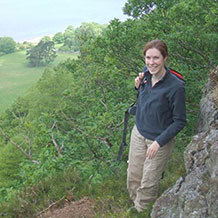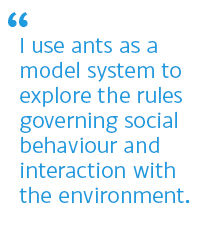Professor Elva Robinson
Professor in Ecology
Research

Social structure in animal groups affects how robust a population is to stresses such as disease, disturbance by humans, or habitat fragmentation. Effects of environmental change on animal social structure are challenging to study but have wide reaching implications for conservation and management. I use ants as a model system which can be manipulated at both the individual and group levels, allowing thorough exploration of the rules governing social behaviour and interaction with the environment. Understanding social structure is essential to for the conservation of any social species, and is also essential for successful control of those social species which have become invasive pests. I use a range of ant species for my research, including the ecologically dominant Formica rufa group wood ants and the invasive garden ant, Lasius neglectus.
I combine controlled lab experiments, field experiments in a more natural context, and computational/analytical modelling, to investigate the organisation of social behaviours and how these relate to environmental conditions and change. I used radio-frequency identification technology to gain individual-level insights into the roles of certain ants within a colony. I collaborate on the analysis of complex patterns of behaviour with other members of the York Cross-disciplinary Centre for Systems Analysis (YCCSA). This work will help explain the mechanisms of organisation and resilience to change in a highly successful group of insects, which will provide insights into the workings of other animal social systems, and even into man-made network systems.
|
Inside a Pharaoh’s ant nest. Thousands of workers care for the eggs, larvae and pupae. Pharaoh’s ants have multiple queens – three are visible in the picture, including one unmated queen with wings. The black-bodied winged insect in the centre is a male. Pharaoh’s ants do not rely on flight of the reproductives for dispersal – instead new colonies bud off from established ones, with workers carrying brood to new locations. This makes them a highly successful pest species. |
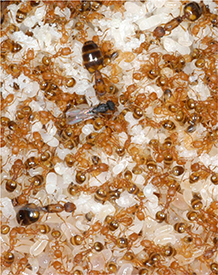 |
|
A multi-nest (polydomous) colony of the wood ant Formica lugubris. The colony is spread out across multiple socially connected nest mounds. I study the network structure of multi-nest colonies such as these to learn about social network dynamics and inter-group cooperation. (Figure credit Sam Ellis) |
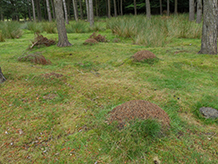 |
| Field study of the wood ant Formica rufa. I study the behavioural ecology of wood ants at many levels, from the interactions within a nest mound, to the landscape-level population processes. | 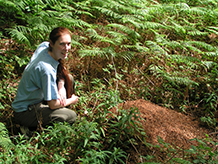 |
| A radio-tagged worker of the invasive garden ant Lasius neglectus. Invasive ants can be highly damaging to native invertebrate communities. I study the impact of invasive species, and investigate the mechanisms underlying their success. | 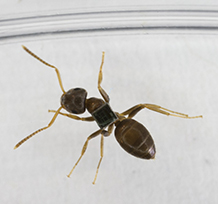 |
Teaching and scholarship
![]()
Throughout my teaching, my aim is enthuse students with an interest in the topics I cover, and to provide opportunities that encourage and nurture their curiosity and critical thinking, enabling them to develop both subject knowledge and critical thinking skills.
![]()
My lectures cover a wide range of animal behaviour, behavioural ecology and evolution of behaviour. I cover how behaviours evolve, how they are maintained, how they can be highly plastic, on both long and short timescales, and how they can have unexpected consequences, especially in anthropogenic environments. I make animated videos to explain core concepts in a simple way, and use interactive tools to promote active engagement in my lectures.
![]() My tutorials come in two main flavours. I hold subject-based tutorials under the broad heading of behavioural ecology, usually with a focus on social behaviour. We discuss the various forms sociality can take, its evolutionary origins and ecological consequences, across a broad range of taxa. I also hold tutorials that cover the relationship between science and the media. In these tutorials we explore the different types of media coverage science receives, the positives and negatives of different approaches, and make our own sci-comm outputs. In both types of tutorial, communication skills are developed, covering both traditional forms of acadmic communication (essay writing, giving formal presentations) and also more creative forms, including making sci-comm videos, or even designing card games.
My tutorials come in two main flavours. I hold subject-based tutorials under the broad heading of behavioural ecology, usually with a focus on social behaviour. We discuss the various forms sociality can take, its evolutionary origins and ecological consequences, across a broad range of taxa. I also hold tutorials that cover the relationship between science and the media. In these tutorials we explore the different types of media coverage science receives, the positives and negatives of different approaches, and make our own sci-comm outputs. In both types of tutorial, communication skills are developed, covering both traditional forms of acadmic communication (essay writing, giving formal presentations) and also more creative forms, including making sci-comm videos, or even designing card games.
![]()
I offer projects inspired by, and often contributing to, the current research going on within my lab-group. Projects may involve behavioural experiments in the laboratory with ants or other invertebrates, analysing existing field or image data. I also offer meta-analysis and modelling projects, but all projects come within the area of the behavioural ecology of social animals.
